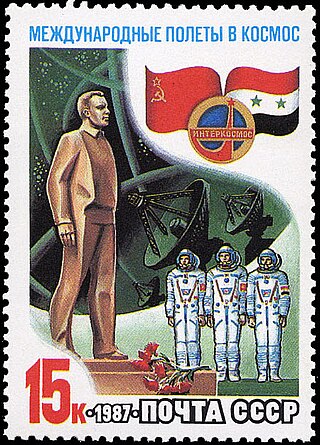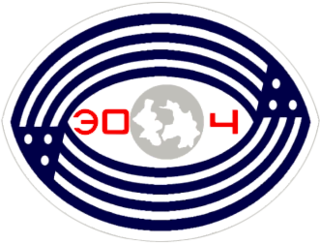
Mir was a space station that operated in low Earth orbit from 1986 to 2001, operated by the Soviet Union and later by Russia. Mir was the first modular space station and was assembled in orbit from 1986 to 1996. It had a greater mass than any previous spacecraft. At the time it was the largest artificial satellite in orbit, succeeded by the International Space Station (ISS) after Mir's orbit decayed. The station served as a microgravity research laboratory in which crews conducted experiments in biology, human biology, physics, astronomy, meteorology, and spacecraft systems with a goal of developing technologies required for permanent occupation of space.

Salyut 5, also known as OPS-3, was a Soviet space station. Launched in 1976 as part of the Salyut programme, it was the third and last Almaz space station to be launched for the Soviet military. Two Soyuz missions visited the station, each crewed by two cosmonauts. A third Soyuz mission attempted to visit the station, but failed to dock, whilst a fourth mission was planned but never launched.

Salyut 6, DOS-5, was a Soviet orbital space station, the eighth station of the Salyut programme. It was launched on 29 September 1977 by a Proton rocket. Salyut 6 was the first space station to receive large numbers of crewed and uncrewed spacecraft for human habitation, crew transfer, international participation and resupply, establishing precedents for station life and operations which were enhanced on Mir and the International Space Station.

Anatoly Yakovlevich Solovyev is a retired Russian and Soviet cosmonaut and pilot. Solovyev was born on January 16, 1948, in Riga, Latvia. Solovyev holds the world record on the number of spacewalks performed (16), and accumulated time spent spacewalking.

Soyuz TM-2 was a crewed spaceflight to the Soviet space station Mir, which was uncrewed at the time. TM-2 was launched on February 5, 1987, and it was first crewed spaceflight of the Soyuz-TM spacecraft, and the second crewed spaceflight to Mir. The crew of the long duration expedition, Mir EO-2, who were launched by TM-2 consisted of Soviet cosmonauts Yuri Romanenko and Aleksandr Laveykin.

Soyuz TM-3 was the third crewed spaceflight to visit the Soviet space station Mir, following Soyuz T-15 and Soyuz TM-2. It was launched in July 1987, during the long duration expedition Mir EO-2, and acted as a lifeboat for the second segment of that expedition. There were three people aboard the spacecraft at launch, including the two man crew of the week-long mission Mir EP-1, consisting of Soviet cosmonaut Aleksandr Viktorenko and Syrian Muhammed Faris. Faris was the first Syrian to travel to space, and as of June 2021, the only one. The third cosmonaut launched was Aleksandr Aleksandrov, who would replace one of the long duration crew members Aleksandr Laveykin of Mir EO-2. Laveykin had been diagnosed by ground-based doctors to have minor heart problems, so he returned to Earth with the EP-1 crew in Soyuz TM-2.

Soyuz TM-4 was a crewed Soyuz spaceflight to Mir. It was launched on 21 December 1987, and carried the first two crew members of the third long duration expedition, Mir EO-3. These crew members, Vladimir Titov and Musa Manarov, would stay in space for just under 366 days, setting a new spaceflight record. The third astronaut launched by Soyuz TM-4 was Anatoli Levchenko, who returned to Earth about a week later with the remaining crew of Mir EO-2. Levchenko was a prospective pilot for the Soviet Space shuttle Buran. The purpose of his mission, named Mir LII-1, was to familiarize him with spaceflight.

Soyuz TM-5 was a crewed Soyuz spaceflight to Mir. It was launched on June 7, 1988, carrying the Mir EP-2 mission's three-person crew. This week-long stay on Mir occurred during the third long-duration Mir expedition, Mir EO-3. The crew of EP-2 returned to Earth aboard Soyuz TM-4, while the TM-5 spacecraft remained docked to Mir, acting as the lifeboat for the long-duration crew. On September 7, 1988, the TM-5 spacecraft undocked from Mir, and landed Mir EP-3 mission's two-person visiting crew. The de-orbit procedures for Soyuz were revised after this flight, as multiple issues almost prevented the descent module's safe de-orbit and landing.

Soyuz TM-8 was a 1989 spaceflight which carried the fifth long duration crew to the Soviet space station Mir. It was part of the Soyuz-TM series of spacecraft, which were the fourth generation of the Soviet Soyuz. Soyuz TM-8 was the eighth crewed spaceflight to Mir, and spent 166 days in orbit.

Aleksandr Panayotov Aleksandrov is a retired Bulgarian cosmonaut. He is the second Bulgarian to have flown to space, behind Georgi Ivanov.

Aleksandr Pavlovich Aleksandrov is a former Soviet cosmonaut and twice Hero of the Soviet Union.

Yuri Viktorovich Romanenko is a former Soviet cosmonaut, twice Hero of the Soviet Union. Over his career, Yuri Romanenko spent a total of 430 days 20 hours 21 minutes 30 seconds in space and 18 hours in space walks. In 1987 he was a resident of the Mir space station, launching on Soyuz TM-2 and landing aboard Soyuz TM-3. He remained on Mir for 326 days; that was the longest stay in space at that time. His son, Roman Romanenko is also a cosmonaut, and has become the third second-generation space traveler on Soyuz TMA-15 in May 2009.
The Bulgarian cosmonaut program refers to human spaceflight efforts by the People's Republic of Bulgaria. The idea of a Bulgarian manned space mission predated the launch of Sputnik 1, the first artificial satellite. An informal proposal for the Soviet Union to send a Bulgarian cosmonaut in space was issued in 1964, but it was not seriously considered by the Soviets. Official space cooperation began in 1966 with the establishment of the Interkosmos programme which allowed Communist Bloc countries to access Soviet space technology and assets.
Mir EO-3 was an expedition to the space station Mir. The crew consisted of 3 people, Musa Manarov (Commander), Vladimir Titov and Valeri Polyakov. Manarov and Titov arrived at the station in December 1987 on Soyuz TM-4, while Polyakov arrived much later, in August 1988 on Soyuz TM-6. After the arrival of Polyakov, medical experiments became more intensive.

Mir EO-4 was the fourth long-duration expedition to the Soviet space station Mir. The expedition began in November 1988, when crew members Commander Aleksandr Volkov and Flight Engineer Sergei Krikalev arrived at the station via the spacecraft Soyuz TM-7. The third crew member of EO-4, Valeri Polyakov, was already aboard Mir, having arrived in August 1988 part way through the previous expedition, Mir EO-3.
Mir EO-5 was the 5th long duration expedition to the space station Mir, which lasted from September 1989 to February 1990. The two person crew was launched and landed in the spacecraft Soyuz TM-8, which remained docked to Mir throughout the mission. The crew are often referred to as the Soyuz TM-8 crew.

Mir EO-2 was the second long duration expedition to the Soviet space station Mir, and it lasted from February to December 1987. The mission was divided into two parts, the division occurring when one of the two crew members, Aleksandr Laveykin, was replaced part way through the mission by Aleksandr Aleksandrov. Laveykin was replaced because ground-based doctors had diagnosed him with minor heart problems.
Mir EP-3 was a week-long crewed spaceflight to the Soviet space station Mir, during the long-duration expedition Mir EO-3. It was the sixth crewed spaceflight to Mir, and was launched with the spacecraft Soyuz TM-6. This spacecraft also carried Valeri Polyakov, who would stay aboard Mir after the crew of EP-3 returned to Earth in Soyuz TM-5. The crew of EP-3, also known as the Soyuz TM-6 crew, consisted of Soviet cosmonaut Vladimir Lyakhov as commander, and the first Afghan to visit space, Abdul Ahad Mohmand.

Mir EO-19 was the nineteenth crewed expedition to the space station Mir, lasting from June to September 1995. The crew, consisting of Russian cosmonauts Anatoly Solovyev and Nikolai Budarin, launched on June 27, 1995 aboard the Space Shuttle Atlantis on the STS-71 mission. After remaining aboard Mir for approximately 75 days, Solovyev and Budarin returned aboard the Soyuz TM-21 spacecraft on September 11, 1995.













